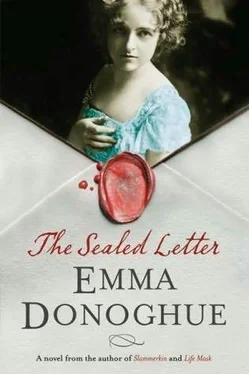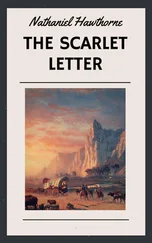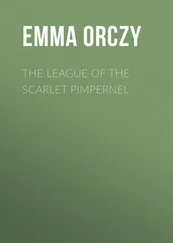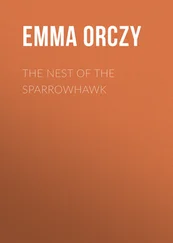Helen shovels it all into her bag: not just bank notes but gold sovereigns, silver crowns and half-crowns and florins and shillings, even. All she leaves is the copper.
Fido watches the rapid pink hands at work. She waits in silence. For what? Some recognition. Some release.
Helen snaps the clasp of her bag, and goes out the door.
Fido sits very still after her visitor has gone. She's looking down the long tunnel of her past. Kent, the weeping woman on the seashore, the first exchange of words. She wishes she could wish that it never happened. Oh Helen, Helen, Helen, the name like the wail of a gull. Love found and complicated and lost, found and destroyed again, and was there any way Fido could have shaped the story differently?
One last thing to do. She reaches under the books for the corner of the letter, and pulls it out. Against the black seal, the paper as white as the neck of a girl. What worse is there to fear, after all?
The seal cracks between Fido's fingers. The folded paper parts like water. The page is blank.
Emily Faithfull (1835-95), "Fido" to her intimates, was one of the leading members of the first-wave British women's movement. Her colleague at 19 Langham Place, Isa Craig, wrote a poem called "These Three," which celebrated Adelaide Procter as Faith, Bessie Parkes as Love, and Fido Faithfull as Hope. Here is the key verse about Fido:
Her clear eyes look far, as bent
On shining futures gathering in;
Nought seems too high for her intent,
Too hard for her to win.
But by the time this optimistic verse was published in English Lyrics (1870), things had changed utterly: Adelaide Procter was dead; Bessie Parkes had married a Frenchman she barely knew (their children would include the writer Hilaire Belloc) and effectively withdrawn from the movement; the HQ of the Reform Firm had shifted from Langham Place to Emily Davies's home; and Fido Faithfull was a pariah.
The Sealed Letter is a fiction, but based on the extensive reports on Codrington v. Codrington in the Times for July 30, August 1 and 2, and November 18, 19, 21, and 24, 1864, supplemented by the Daily Telegraph, Spectator, Reynolds's Magazine, and Lloyds's Weekly London Newspaper. Very closely based, in fact: for instance, the letter Helen sends Anderson protesting against his engagement, in this novel, is almost word for word the same as the one read aloud in court. What might seem like anachronistic allusions to the Bill Clinton impeachment, such as the stained dress, or the argument about whether a woman could have sex with a man without that man having sex with her, are real details from the Codrington trial. The only major change I have made is to compress the couple's legal wranglings of the period 1858 to 1866 into the novel's more dramatic time span of August to October 1864.
It is a matter of record that Emily "Fido" Faithfull, called as a witness by the wife, fled to avoid a subpoena, then returned to testify in the husband's favour. But why? Robert Browning certainly thought he knew, when he sent his spinster friend Isa Blagden the following tidbit on January 19, 1865:
One of the counsel in the case told an acquaintance of mine that the "sealed letter" contained a charge I shall be excused from even hinting to you-fear of the explosion of which, caused the shift of Miss Emily from one side to the other. As is invariably the case, people's mouths are opened, and tell you what "they knew long ago" though it seems that did not matter a bit so long as nobody else knew.
Because the document was not opened in court or entered into the trial record, we are unlikely ever to know what was in it.
William E. Fredeman in "Emily Faithfull and the Victoria Press: An Experiment in Sociological Bibliography" (Library, 5th series, 29, no. 2 [June 1974]: 139-64) was the first to spell out Browning's sly hints about the "sealed letter"; he argues that Admiral Codrington must have used it to blackmail Faithfull into changing sides.
By contrast, James Stone's biography of his wife's great-great-aunt, Emily Faithfull: Victorian Champion of Women's Rights (1994), attributes her volte-face to her sense of betrayal that Helen had broken her promise not to drag her into court.
The first thorough reading of this complex case was an essay by Martha Vicinus ("Lesbian Perversity and Victorian Marriage: The 1864 Codrington Divorce Trial," Journal of British Studies 36 [1997]: 70-98, also included in her book, Intimate Friends). Based on exemplary research into all the participants as well as a close study of the newspaper coverage and legal documents, this brilliant analysis was invaluable to me in writing The Sealed Letter. Vicinus is not convinced by Stone's theory that Helen Codrington and her lawyer conned a naïve Faithfull into approving Few's affidavit. In this account, Faithfull emerges as an astute businesswoman who gave a brilliant performance in the witness box, drawing on Victorian preconceptions (for instance, about the naïve girl led astray by the older married woman) to get herself off the hook.
In creating my own "Fido," "Helen," and "Harry," and attempting to solve the ill-fittingjigsaw puzzle that is the Codrington case, I have borrowed ideas from these three historians and others.
Four years after testifying in the trial, Fido mulled over her experiences with Helen Codrington, more in sorrow than in anger, in a bestselling novel called Change upon Change (1868). The persona she adopts is that of a sober man called Wilfred, helplessly devoted and secretly engaged to his flighty cousin Tiny. "Women have so many natures," he concludes wistfully; "I think she loved me well with one." In the preface to the American edition of 1873 (renamed A Reed Shaken in the Wind), Fido admitted
I have seen with my own eyes the curious combination of intellectual power and instability of purpose portrayed in Tiny Harewood; I have watched with an aching heart the shifting weaknesses and faint struggles for redemption described in these pages.
At least some of the Faithfull clan seem to have stood by Fido. At the time of the trial, she also had one loyal friend I have left out of the story, Emy Wilson (discussed in Martha Westwater's The Wilson Sisters).
I have simplified and compressed many events at Langham Place in the early 1860s, including the death throes of the English Woman's Journal and the founding of the Victoria Magazine and Alexandra Magazine. I have used quotations, paraphrases, incidents, and details from the papers of Bessie Parkes Belloc, her father Joseph Parkes, her daughter Marie Belloc Lowndes, and her colleagues Barbara Smith Bodichon, Emily Davies, and Adelaide Procter. Some of these papers are published, but most are held in manuscript at Girton College, Cambridge-the college for women that Davies founded in 1869. (When I did my PhD at Girton in the 1990s, I had no idea I would be returning one day to research a novel, and I want to thank archivist Kate Perry for her help and insights during my week-long visit in 2005.)
Though voluminous, the letters of the "Reform Firm" are often tantalizingly euphemistic. At points of crisis-such as the ousting of the fascinating Matilda "Max" Hays from the Journal, or Bessie Parkes's breaking off of relations with Fido-letters or entire sequences have been lost or (more likely) censored by heirs. For instance, the letter in which Parkes reports discovering Fido's involvement in the Codrington case is missing at least the first page. This means that much of my novel's depiction of relations among the women of Langham Place has to be guesswork. For factual accounts of these key years in British feminism I recommend Pam Hirsch's Barbara Leigh Smith Bodichon: Feminist, Artist and Rebel, Candida Ann Lacey's anthology, Barbara Leigh Smith Bodichon and the Langham Place Group, and Jane Rendall's essay on the English Woman's Journal in her Equal or Different: Women's Politics 1800-1914.
Читать дальше












